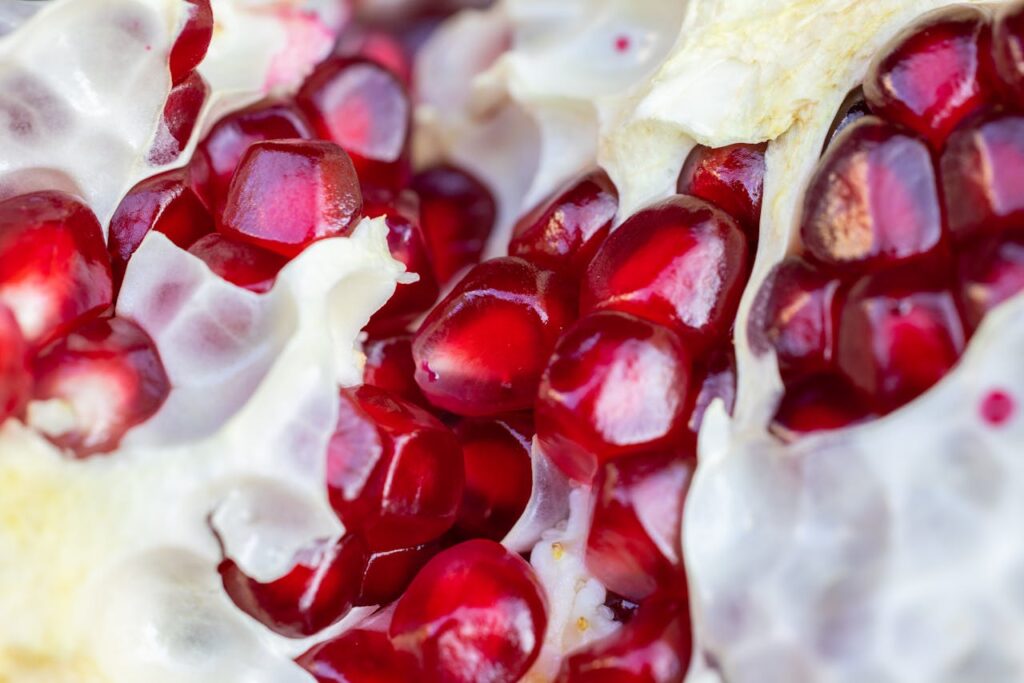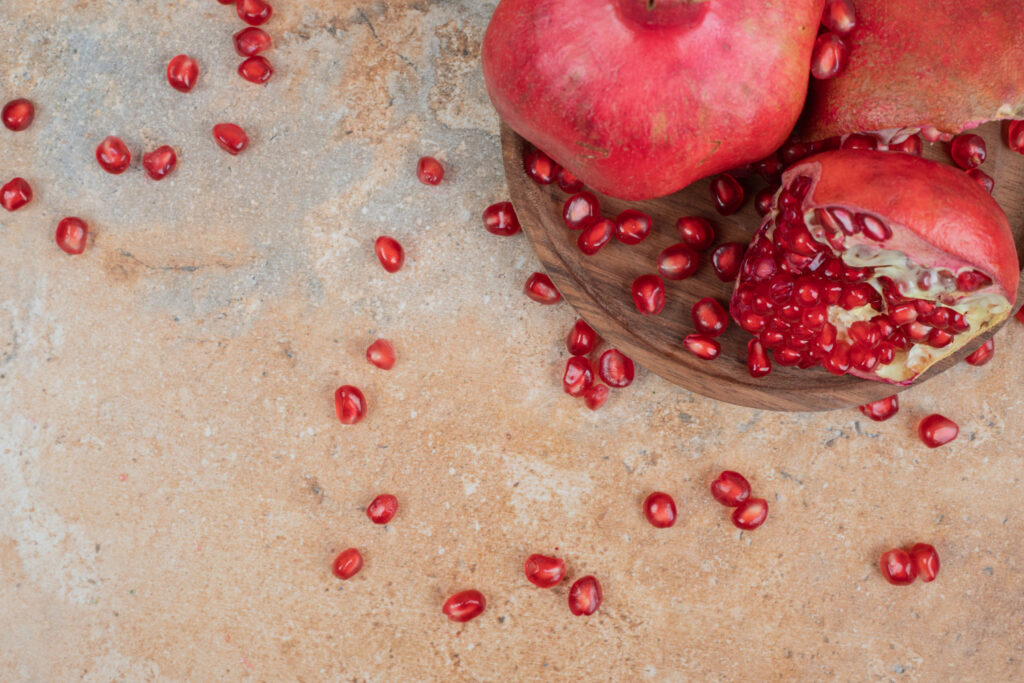
Pomegranates are sweet and tart fruits encased in thick, red skin. Although the skin is not edible, it houses hundreds of juicy seeds known as arils, which can be eaten alone or sprinkled on various dishes such as salads, oatmeal, and hummus.
Historically, pomegranates have been cherished for their health benefits. Modern studies confirm that the antioxidants in pomegranates can protect heart health. They also possess anti-inflammatory and antitumor properties, which hold potential for cancer treatment and prevention, though further research is needed.
The typical method of consuming a pomegranate involves cutting it open to reveal the arils inside.
Pomegranates thrive on tall shrubs that require significant heat to ripen the fruit. They are native to Iran and northern India but are also cultivated in the U.S., primarily in California.
Pronunciation of Pomegranate
Pomegranate is pronounced as “paa-muh-gra-nuht.”
Pomegranate Season
In the Northern Hemisphere, pomegranates are in season from September to November, but their long shelf life allows them to be available in stores until January. Pomegranate juice, however, is available year-round.
Pomegranate Seeds
The interior of a pomegranate is divided into chambers filled with hundreds of edible seeds. The term “pomegranate” comes from the Latin phrase “pomum granatum,” meaning “apple of many seeds.” The seeds, called arils, are covered in a fleshy, brightly colored tissue that releases juicy pulp when broken.
Can You Eat Pomegranate Seeds?
While the peel is inedible, the seeds can be juiced or eaten directly. They can be added to salads, cereal, and yogurt for a nutritious boost.
Health Benefits of Pomegranates

Pomegranates offer numerous health benefits primarily due to their high antioxidant content. They contain up to three times more antioxidants than green tea or red wine. Antioxidants help protect cells from damage and reduce inflammation.
Heart Health
Pomegranates are rich in polyphenols, antioxidants that may protect against heart and blood vessel diseases, including atherosclerosis and high blood pressure. The polyphenol compounds, punicalagins, and ellagitannins help prevent artery walls from thickening and reduce cholesterol buildup. Pomegranate juice also contains anthocyanins and anthoxanthins, which support heart health by lowering LDL (“bad”) cholesterol and increasing HDL (“good”) cholesterol.
In clinical trials, pomegranate extract supplements reduced body weight, serum glucose, insulin, triglycerides, total cholesterol, LDL-to-HDL ratio, and inflammation markers in people with overweight or obesity.
Studies show that pomegranate seed extract can lower blood pressure by reducing oxidative stress, decreasing inflammation, and improving hypothalamus function, which regulates appetite, body temperature, and blood pressure.
Cancer Prevention
The high antioxidant and flavonoid content in pomegranates may help prevent free radical damage to cells. Early studies suggest potential in preventing prostate, breast, lung, and colon cancers. Animal studies indicate pomegranates may inhibit tumor growth in these areas, but more research is necessary to confirm these effects in humans.
Diabetes Management
A study found that drinking approximately 200 milliliters of pomegranate juice daily for six weeks lowered blood pressure in people with type 2 diabetes. Pomegranate seed oil has also been shown to reduce fasting blood sugar levels, although it did not affect insulin levels. Early studies suggest pomegranate juice may improve insulin resistance in type 2 diabetes patients, but further research is needed.
Urinary Health
Early research indicates that pomegranate extract may help prevent kidney stones by lowering blood concentrations of oxalates, calcium, and phosphates, common chemicals in kidney stones.
Digestive Health
Pomegranates may have prebiotic effects, supporting the health of your gut microbiome. The gut microbiome protects against chronic diseases like inflammatory bowel disease (IBD), type 2 diabetes, heart disease, and colorectal cancer. Whole pomegranate seeds are also high in fiber, promoting digestive health.
Brain Health
Ellagitannins, polyphenols in pomegranates, reduce inflammation throughout the body. Early studies suggest they may protect the brain from Alzheimer’s and Parkinson’s diseases by combating free radical damage and inflammation.
Joint Health
A systematic review of studies suggests that pomegranate antioxidants may alleviate symptoms and prevent complications in rheumatoid arthritis. Another study indicates pomegranates may also prevent osteoarthritis.
Pomegranate Nutrition
Fresh pomegranates are nutritious, low in calories and fat, and high in fiber, vitamins, and minerals.
Nutrients per Serving

One serving is about half a pomegranate, providing:
- Calories: 72
- Protein: 2.35 grams
- Fat: 1.6 grams
- Carbohydrates: 26 grams
- Fiber: 5.5 grams
- Sugar: 20 grams
An 8-ounce serving of pomegranate juice contains:
- Calories: 135
- Protein: 1 gram
- Fat: 0 grams
- Carbohydrates: 34 grams
- Fiber: 1 gram
- Sugar: 30 grams
- Sodium: 10 grams
How to Open a Pomegranate
To open a pomegranate, cut off both ends. Cut along the ridges from top to bottom deep enough to penetrate the skin and white membrane but not the seeds. Hold the fruit over a bowl of water and separate it with your fingers. The seeds will sink, and the membrane will float. Remove and discard the membrane, then drain the water from the seeds.
How to Eat Pomegranate
Pomegranate Recipes
- Sprinkle seeds on yogurt and granola for a parfait or light dessert.
- Blend juice with bananas and yogurt for an antioxidant-rich smoothie.
- Add seeds to a quinoa salad with fresh fruits and vegetables.
- Add seeds to a dinner salad for a tangy pop.
- Use seeds as a crunchy accent on pizza or pasta.
- Make a salad dressing with pomegranate juice, rice vinegar, oil, garlic, and sugar.
Pomegranate Molasses
Pomegranate molasses is a syrup made by boiling down pomegranate juice, sometimes with added lemon juice and sugar. It is commonly used to marinate meat or make salad dressings and is popular in West Asian cuisine.
Pomegranate Juice
Pomegranate juice, especially common in Iran, is now widely available. It retains most of the health benefits of the seeds but loses almost all fiber and much of the vitamin C content when juiced. The juice retains high potassium levels, vital for nerve and heart health. When choosing pomegranate juice, opt for “100% juice” to avoid added sugars.
Making Pomegranate Juice
Remove the seeds and press them to release the juice. A large pomegranate yields about a quarter to half a cup of juice. You can crush the seeds in a food mill or sieve or blend them and strain the mixture to remove pulp. Juice can be frozen or canned for longer storage, adding lemon juice to maintain color when canning.
Pomegranate Tea
Pomegranate tea, rich in nutrients, is made by adding crushed seeds, dried flowers, or juice concentrate to tea leaves or brewed tea. It is available in grocery stores and can be mixed with mint, black tea, or green tea. Pomegranate tea provides antioxidants and vitamins, including A, C, E, B-complex, and trace minerals like copper, magnesium, phosphorus, and zinc.
Pomegranate Cocktails
Pomegranate juice can enhance cocktails, such as:
- Pomegranate Martini: Mix pomegranate juice, vodka or white tequila, Cointreau, sparkling water, and lemon juice. Shake with ice, pour into martini glasses, and garnish with seeds.
- Pomegranate Margarita: Combine white tequila, pomegranate juice, lime juice, agave nectar, and a pinch of salt. Shake with ice, strain into a tumbler, and garnish with a lime wedge.
For mocktails, substitute sparkling water for alcohol.
Pomegranate Side Effects
Pomegranates are generally safe to eat, but some may experience allergic reactions. Those with plant allergies should watch for symptoms like hives or difficulty breathing. Diabetics should note the high sugar content. People with kidney disease should be mindful of the potassium content. Pomegranate may interact with certain medications, including ACE inhibitors, cholesterol drugs metabolized in the liver, and blood thinners. Consult a doctor if you’re taking these medications.
Growing Pomegranates
Pomegranates grow on dense, multi-trunked shrubs or single-trunked trees with thorny branches and dark green leaves, reaching up to 10-12 feet tall.
How to Grow Pomegranates
Pomegranates thrive in warm climates with temperatures over 85°F (29°C) for at least 120 days a year. They prefer loamy, well-drained soil and at least six hours of direct sunlight daily. To grow a pomegranate shrub, start with a hardwood cutting from a larger shrub in late fall or early winter. Plant the cutting in a pot and transplant it in spring. Mature shrubs will flower and bear fruit, typically harvested between August and November. Allow fruit to ripen on the tree for the best flavor, and handle it gently during harvest to avoid puncturing the skin.
Takeaways
Pomegranates are red, round fruits packed with crunchy, juicy seeds called arils. They have been valued since ancient times for their health benefits. Rich in powerful antioxidants, pomegranates can protect heart, kidney, and gut health and may help guard against Alzheimer’s, Parkinson’s, and some cancers. Incorporate pomegranates into your diet by adding their seeds to salads, oatmeal, hummus, or other dishes
A Quick Review
Pomegranates are a powerhouse of nutrition, offering numerous health benefits. Rich in antioxidants, they support heart health, may prevent certain cancers, and help manage diabetes. The edible seeds (arils) are delicious in salads, yogurt, and other dishes. Available fresh from September to January, pomegranate juice can be enjoyed year-round. Incorporating pomegranates into your diet is a tasty way to boost your overall health.











